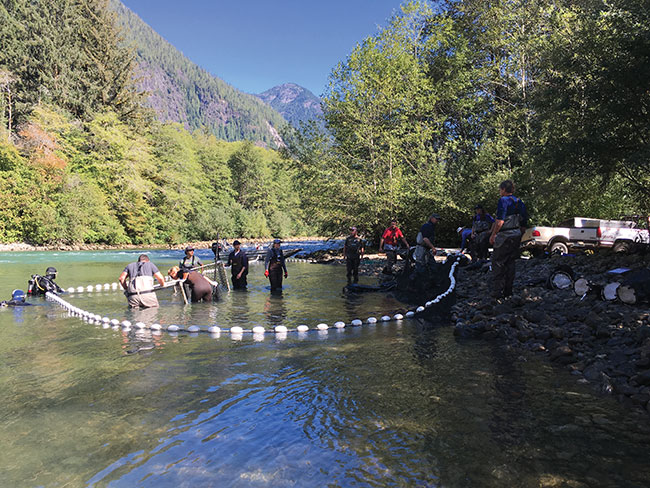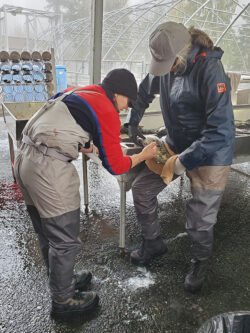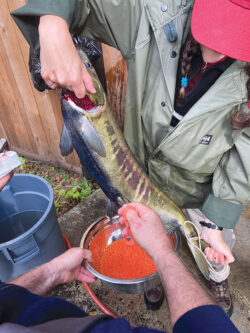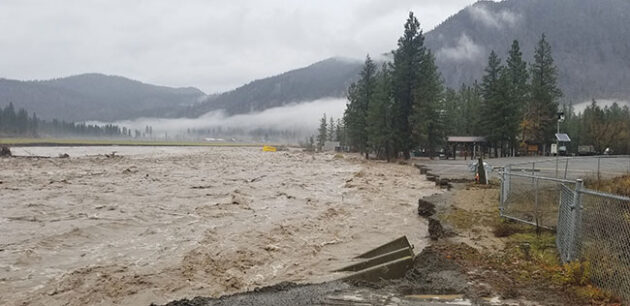
Features
Hatchery Operations
Genetics Week
Regulations
Canada on a mission
With once-in-a-generation funding, the plan to reform and modernize hatcheries takes shape.
April 19, 2023 By Lynn Fantom
 Phillips River chinook broodstock collection
Photos: Fisheries and oceans canada
Phillips River chinook broodstock collection
Photos: Fisheries and oceans canada Emerging science has led some conservationists to question whether hatchery production was a cost-effective restoration tactic and to sound alarms about the practice of releasing hundreds of millions of domesticated hatchery fish to mix with wild salmon.
But an eye-popping C$647 million (US$473.6 million) was earmarked in the 2021 budget of the Government of Canada which signalled a new confidence and urgency to rebuild the drastically declining populations of Pacific salmon.
Called the Pacific Salmon Strategy Initiative, Fisheries and Oceans Canada (also known as DFO) is carrying out a five-year strategy that includes habitat restoration, management of commercial harvests, and deep collaboration with stakeholders — along with a sophisticated, science-based approach to hatcheries.
“We used to make mistakes, right? We thought a fish was a fish, and we would distribute them all over the place and wonder why they wouldn’t survive. Not just the DFO, but fisheries managers throughout the world,” said Michael Crowe, a regional manager of Salmonid Enhancement Program (SEP), which was founded in 1977.
“We now have so much more information about their biology and nature.”
An evolving focus
“We’re basically moving from the origins of the program, which were more around production for harvest, to a broader one with a conservation focus,” said Corino Salomi, the regional manager of DFO’s Enhancement Operations. “Originally, a lot of the production was relatively high numbers to directly feed recreational, First Nations, and commercial fishing. And what we’re really trying to do is add the capacity to help rebuild or restore stocks that are at a lower conservation status.”

Puntledge River Hatchery in Courtenay, B.C. was built to save chinook salmon from extinction and rebuild other species.
The DFO operates 17 hatcheries, most of which are located on rivers and focus on the species of that river, according to Salomi. But now conservationists have identified problems in other rivers, farther away from where the current hatcheries are located. So, programs are going to have to involve more transport activities.
Such an effort requires a crew to collect broodstock from that river, transport it to the hatchery facility to conduct “a small, discrete conservation program with that stock,” and then transport the juvenile fish back.
“We’re facing and trying to manage extinction risks,” Crowe emphasized.
So, in terms of hatchery infrastructure, that will mean replacing large, long raceways with smaller rearing containers, as well as increasing biosecurity controls and transport capabilities.
“Our objective is now to go from large numbers of a few stocks to many stocks but in fewer numbers,” he added.
Even though this is “a massive generational investment,” as regional manager Adam Silverstein described, the 2021 federal commitment will need to focus on “some major renovations at a couple of facilities and then a cascading series of upgrades in terms of equipment across the rest of the infrastructure.”
These will include increasing good surface and ground water as well as enhancing incubation flexibility such as the UV sterilization and chilling needed for different stocks. Back-up infrastructure, ranging from generators to alarms, will also rank high due to its importance in times of extreme weather events.
“We might have the last few gametes of a population in a particular location, and we need to protect those with all the resources that we have,” added Silverstein, who is overseeing the hatchery reform and modernization.
In addition, the program will build two new facilities in the mid and upper Fraser River, where unprecedented rains, landslides, and elevated water temperatures have challenged chinook and sockeye salmon in recent years. Also under consideration are four other hatcheries that would be operated by First Nations communities or volunteers in collaboration with the DFO for the shared purpose of conservation. The goal is to locate new facilities where the conservation concern exists.
Research capacity
“There is a ton of science that is emerging around enhancement techniques, both the benefits and the risks,” Silverstein said. “We are in a much better position to understand the genetic composition of salmon populations and the roles that hatcheries might have in influencing those.”

A technician assists in the egg take of a salmon at Zeballos Hatchery on Vancouver Island. This hatchery is operated by the Ehattesaht/Chinexint First Nation
To that point, a 2018 paper published in Marine and Coastal Fisheries examined levels of pink, chum, and sockeye salmon in the North Pacific from 1925-2015 and zeroed in on whether they originated in the wild or in hatcheries. A key finding is that hatchery salmon represented approximately 40 per cent of the total biomass of adult and immature salmon in the ocean.
In addition, recent abundance of these particular salmon species is “the highest since the collection of relatively comprehensive statistics began in 1925,” wrote the authors, reflecting “generally favourable ocean conditions and, in recent decades, releases of large numbers of hatchery salmon combined with improving hatchery technologies after 1990.”
In contrast though, they noted declines in natural-origin chinook salmon, coho salmon, and steelhead in the eastern North Pacific. Because salmon compete for food at sea, researchers hypothesized that in Alaska, for example, declines among chinook and coho salmon may be related to the alteration of the food web by highly abundant pink salmon. They also pointed to an empirical model based on several decades of data that predicted an 18 per cent decline in productivity of natural-origin British Columbia Fraser River sockeye salmon (1.8 million fish each year) in response to an increase of 50 million adult hatchery pink salmon in North America.
The researchers urged marking or tagging hatchery salmon so that they can be identified after release. A coded wire tag program has been in existence since the 1970s, but under the DFO initiative, the capacity for marking will increase, as well as leverage new technology, said Silverstein. For coho and chinook salmon, the program is already collecting DNA of the broodstock. It is also intensifying its study of mass marking and mark selective fisheries.

Recent flooding at Spius Creek Hatchery in Merritt, B.C.
A keystone species
Climate, competition for food, habitat degradation, damming of rivers, and pressure from fisheries have all threatened Pacific salmon populations, which have significant commercial, cultural, and social value.
For example, over 200,000 people visit the Capilano River Hatchery in North Vancouver annually to learn more about the iconic species and, at the right time of year, witness salmon swimming past to spawn further up the river. In addition to being a tourist attraction, it is an operating hatchery and one that will be benefiting from a C$50 million (US$36.6 million) rebuild as part of the Pacific Salmon Strategy Initiative funding.
The new facility will feature “all of the modern technologies” for fish rearing, according to engineering expert, Shaun Loader, as well as incorporate design best practices for water use, heating water with renewable sources, locally sourced building materials, and reusing excess heat by having the public center and the hatchery facility together.
The new interpretative centre — and the project overall — will also reflect the in-depth collaboration that has been occurring with strategic partners, including municipal representatives and members of local First Nations communities.
“For me, it’s not the engineering exercise, but this collaboration that’s been the most rewarding part of the rebuild,” said Loader, who visited the hatchery as a kid and has since taken his own child there.
The stakes are high and the challenge is daunting. For one reason, there are so many Pacific salmon populations on the central coast of British Columbia—according to one researcher, 79 different groups that are genetically, ecologically, and spatially distinct.
“They have evolved in different streams to the specific conditions of those streams — latitude, elevation, size of the stream, water temperature, migration distance — to the point that you can’t treat them all the same,” emphasized Crowe. “Their migration timing leaving and, more importantly, coming back in as adults can be very different based on the stock. So it’s very, very important that we manage these fish at that small geographical unit.”
The massive hatchery rebuild is one step in the right direction that has several strategic pathways. Will it succeed?
“If you follow the science, this is going to be challenging. We are facing very difficult conditions,” said Silverstein. “But what I am optimistic about is that people care very deeply about salmon across BC.”
This article is part of the Genetics Week
Print this page





